Jennifer L. Martin, PhD
- Research Health Scientist and Psychologist, VA Greater
- Los Angeles Healthcare System Sepulveda Ambulatory
- Care Center
- Assistant Research Professor, University
- of California, Los Angeles, CA, USA
Imodium dosages: 2 mg
Imodium packs: 30 pills, 60 pills, 90 pills, 120 pills, 180 pills, 270 pills, 360 pills

Order imodium 2mg free shipping
The research of pharmacoepigenetics at a genome-wide stage is referred to as pharmacoepigenomics [100]. Examples are chemotherapeutic drug publicity [103], tobacco publicity [104], and antiepileptic drug exposure [105]. Furthermore, the identification of extremely delicate, particular, and easily accessible epigenetic biomarkers and making use of them along with the genetic biomarkers is a key step towards successful personalised treatment. The metabolome represents the entire repertoire of small molecules (metabolites) present in cells, tissues, or physique fluids, and is analyzed predominately using mass spectrometry and nuclear magnetic resonance spectroscopy applied sciences. Genome, age, well being standing, intercourse, intestine microbiome, nutrition, and other elements can affect the metabolic profile of a person. Some of those components are identified to affect the individual response to a particular drug. As such, metabolomic profiles obtained prior to, during, and after drug treatment might present insights into the mechanism of action of drugs and variations in response to treatment [107e109]. This network has the goal of integrating the rapidly evolving science of metabolomics with molecular pharmacology and pharmacogenomics to transfer towards the aim of "individualized" drug remedy and subclassification of diseases based on therapy outcomes. An early examine in people investigated effects of three antipsychotics in schizophrenia sufferers, compared their effects on metabolism and outlined a lipid signature at baseline related to remedy outcomes [111]. Later, many different research have proven metabolic profiles providing insights into variations in response 212 Chapter 10 Pharmacogenetics and customized medication to antipsychotics, statins, antidepressants, antihypertensives, antiplatelet therapies, and growth of unwanted effects of remedies [112e116]. Finally, pharmacomicrobiomics is an rising field that investigates the interaction of microbiome variation and drug response. The intestine microbiota forms a 3rd dimension in drug metabolism, providing a nonoverlapping enzymatic capacity that generates distinct metabolites from host enzymatic products and can also form drug pharmacokinetics [120]. The gut microbiota alters medication by various mechanisms: degradation, activation, and modulation of drug-metabolizing host enzymes [120,121]. In explicit, in cancer gut micro organism affect the response to chemo-, radio-, and immunotherapeutic drugs by modifying either efficacy or toxicity [122e124]. In addition, intratumor micro organism might modulate chemotherapy response, and at the same time, anticancer treatments may affect the microbiota composition, disrupting homeostasis and aggravating discomfort to the affected person [125]. This interplay between microbiota and anticancer medication is enjoying a rising curiosity, as are interventions aimed at shaping microbiota to optimize drug efficacy and scale back unwanted effects [126,127].
Buy imodium 2 mg with mastercard
The use of nonionic myelographic brokers is now standard, and these brokers have been shown to be safer than ionic formulations. Epidermoid Tumors Headache and related nausea and vomiting are essentially the most frequent problems of lumbar puncture and myelography. The incidence of headache after myelography decreased with the development of nonionic, water-soluble contrast agents. The incidence of postdural puncture headache can be reduced by means of a small-gauge lumbar-puncture needle. The latency between lumbar puncture and headache onset ranges from 6 to Iatrogenic intraspinal epidermoid tumors have been reported as sequelae of lumbar puncture. It is believed that implantation of epithelial cells from the pores and skin into the thecal sac or the epidural space during lumbar puncture could enable this benign tumor to grow progressively. The incidence of iatrogenic epidermoid tumors is exceedingly uncommon, but up to 40 p.c of those occurring in the lumbar backbone are thought to relate to prior lumbar puncture. The time from lumbar puncture to tumor presentation is often from 2 to eight years. The presence of this rare tumor should arouse suspicion of possible iatrogenic causes, and a historical past of prior lumbar puncture must be sought. Acute epidural hematoma complicating myelography in a normotensive affected person with regular blood coagulability is rare but has been reported. The Society of Interventional Radiology published consensus tips in 2019 for the administration of coagulation status prior to image-guided procedures. Puncture of the Spinal Cord Although unusual, puncture of the spinal wire has been described throughout lumbar puncture. This complication could be averted by limiting lumbar punctures to beneath the L2 degree. This route of administration has been associated with a barely greater incidence of headache, nausea, and vomiting than with the C1�C2 puncture; nonetheless, using low-dose, nonionic, water-soluble agents has reduced these complications to an appropriate stage. The injection of distinction materials into the spinal twine could also be associated with hemorrhagic necrosis of the grey matter and acute neurologic decline.
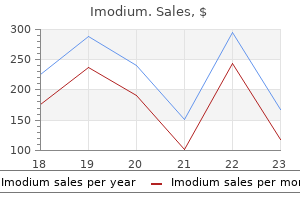
2mg imodium purchase free shipping
Ventilator withdrawal could also be achieved by extubation or by "terminal weaning" (in which ventilator fee, constructive end-expiratory stress, or tidal quantity is progressively reduced with the endotracheal tube in place). For acutely aware sufferers requesting sedation for ventilator withdrawal, Brody and colleagues suggest 2 to four mg of midazolam intravenously before withdrawal, and 5 to 10 mg of morphine by intravenous bolus for misery during weaning, followed by continuous infusion (50% of bolus dose per hour); in sufferers with tolerance to such agents because of prior use, greater doses are needed. Neuromuscular blocking brokers ought to be discontinued before withdrawal of ventilator help, and indeed most likely in all dying patients, to allow verbal communication when this is in any other case possible and to allow indicators of misery to be manifest so that acceptable treatment could be provided. Attention have to be dedicated to vitamin, hydration, care of the skin, and sphincter perform. There are benefits of withholding nutrition and hydration to shorten life when different treatment is to be discontinued. Withdrawal of synthetic diet and hydration, nevertheless, has explicit emotional implications for most people and tons of clinicians. Such a course subsequently calls for particular dialogue with sufferers (when communication is possible) and relations, as well as with other members of the healthcare staff who could additionally be involved. When misery does observe withdrawal of diet or hydration, extra symptomatic measures are essential. Mouthwashes could relieve poor oral hygiene, and antimonilial remedy is indicated for candidiasis, antiemetics for nausea, and opiates or benzodiazepines for restlessness or ache. Thus, the major target is on comfort measures, and nonessential medications and interventions (such as blood checks, intravenous fluids, and the like) are discontinued. Relief of pain, agitation, respiratory problem, and different distressing symptoms is assured. There should be good communication with the affected person, family, and primary medical practitioner, and the plan of care should be defined to them and understood. Various structured methods have been developed to facilitate care practices and monitor their results. It can also facilitate dialogue about such troublesome points as fears of dependence, incapacity, and death.
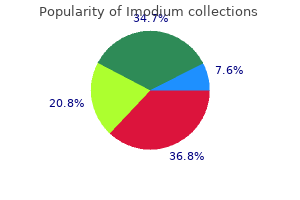
Imodium 2 mg visa
At onset the dystonia is focal or, rarely, segmental, and generally spreads over a variable period which could be as quick as a number of months or so long as 20 to 30 years, resulting in segmental dystonia, hemidystonia, or generalized dystonia. Postoperative encephalopathy with chorea, also called postpump chorea, consists of chorea, athetosis, or ballismus, episodic eye deviations, and hypotonia. It occurs in infants or children within 12 days of cardiac surgical procedure involving hypothermia, cardiopulmonary bypass, and often full circulatory arrest, and could additionally be severe. Although this surgical complication was previously frequent, occurring in as a lot as 20 percent of kids, current methods have drastically decreased its incidence. Risk factors embody age at time of surgical procedure (higher risk between 6 months and 5 years), speedy cooling throughout cardiopulmonary bypass, lower physique temperature, and the duration of hypothermic circulatory arrest. Infants youthful than 6 weeks are less vulnerable; in older infants, the chorea is commonly delicate and reversible. The pathophysiology is poorly understood, although it seems likely that hypoxic-ischemic mechanisms secondary to surgical method (including deep hypothermia) play a role. Children and young adults sustaining acute hypoxic harm may develop dystonia. They normally have focal or unilateral findings clinically and on imaging studies, regardless of the worldwide insult. Dystonia could develop after 1 week to three years and sometimes generalizes over the next months or years; imaging reveals abnormalities especially within the putamen. Polycythemia rubra vera has a male predominance, but polycythemic chorea is more widespread in ladies. Neurologic manifestations of polycythemia are frequent, occurring in 50 to eighty percent of patients, and embody headache, vertigo, stroke, visible signs, tinnitus, and paresthesias. The chorea will be the presenting symptom of polycythemia, may start all of a sudden or progressively, is sometimes episodic, and sometimes turns into generalized but affects significantly the facial, lingual, and brachial muscular tissues.

Cheap 2mg imodium free shipping
Postoperative Delirium Postoperative delirium is frequent, with a reported incidence as excessive as 40 to 60 % of sufferers. The danger of delirium is increased within the elderly and in sufferers with earlier cognitive impairment, a history of substance use (including alcohol), and people receiving polypharmacy before surgical procedure and narcotics or benzodiazepines perioperatively. Perioperative hypoxemia and hemodynamic instability, profuse intraoperative blood loss, and postoperative organ failure may increase the danger of postoperative delirium. There is limited evidence that the sort and route of anesthesia influence the chance of postoperative delirium, with higher charges following common anesthesia. Evaluation of patients with postoperative delirium begins by contemplating risk components for its improvement (see Table 54-2 in Chapter 54). Time ought to be spent reviewing the medicines that the patient was taking previous to surgical procedure and people administered throughout and after the operation. Exclusion of acute structural brain harm, seizures, and meningoencephalitis (a rare cause of perioperative coma) is the primary duty of the consulting neurologist. Primary neurologic diagnoses to be thought of embody ischemic infarctions (often bilateral or within the brainstem), intracranial hemorrhage (intraparenchymal, subdural, or rarely subarachnoid), nonconvulsive status epilepticus, and posterior reversible encephalopathy syndrome. Discontinuation of sedatives and narcotics is commonly the one intervention required. Dexmedetodimine, a central 2-adrenergic agonist, is especially useful for extra sedation or when agitation is accompanied by sympathetic hyperactivity. Benzodiazepines could worsen delirium and subsequently must be reserved for particular indications, such as alcohol withdrawal. Complications typically stemming from it embody aspiration, self-removal of the endotracheal tube or indwelling catheters, and delays in mobilization that, in turn, lead to an elevated threat of thromboembolism, infections, and deconditioning. In addition, the prevalence of postoperative delirium is said to a higher threat of postoperative cognitive dysfunction, particularly during the first few months following surgery. Its incidence is biggest after main cardiovascular surgery, ranging from 30 to 80 % during the first few weeks after surgery and 10 to 60 p.c after 3 to 6 months. Patients affected by this complication, even when transient, might have worse long-term cognitive outcomes, larger incapacity (particularly in the elderly), and the next mortality.
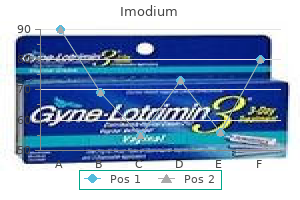
Discount 2mg imodium with visa
The chronic kind presents as chronic limb-girdle weakness with preserved reflexes. Electrodiagnostic testing has proven slowing of nerve conduction velocities and low compound muscle motion potential amplitudes. The instant remedy goal is to prevent a cardiac arrhythmia, which can be achieved with an infusion of calcium gluconate. In mild cases, weak point may be restricted to the legs, however in severe instances quadriplegia with neuromuscular respiratory failure could occur. The subacute myopathy associated with hypokalemia is characterised by the onset of proximal limb weakness over weeks to months. Occasionally, the course could also be extra rapid, associated with myalgia, tenderness, and myoglobinuria. A number of metabolic derangements could contribute to this situation, including secondary hyperparathyroidism, impaired vitamin D metabolism, carnitine deficiency, and decreased clearance of poisonous "middle molecules. Most of these cause a necrotizing myopathy that presents clinically with the acute to subacute onset of generalized weakness. Pathologically, necrosis and regeneration of muscle fibers occur, with myophagocytosis. Statins (3-hydroxy-3-methylglutaryl-CoA reductase inhibitors), fibric acid derivatives (clofibrate, gemfibrozil, and others), organophosphates, -aminocaproic acid, and hypervitaminosis E are all related to a necrotizing myopathy. Any medication that lowers potassium levels, together with diuretics, licorice, and laxatives, may produce a myopathy. Chronic hydroxychloroquine or colchicine use can cause vacuolar myopathy; impaired renal operate significantly will increase the chance of colchicine-induced myopathy. Once the offending medicine is discontinued, most sufferers make a fast and full recovery. In a subset of patients, nevertheless, the myopathy persists despite drug discontinuation. If the focus of myoglobin in the urine surpasses 250 g (normal is less than 5 ng/mL), the urine will have a cola-color tinge. Management consists of hydration with alkaline fluids and induced diuresis with hyperosmolar agents corresponding to mannitol. Electrolyte imbalances, corresponding to hyperkalemia or hypocalcemia, could trigger cardiac arrhythmias and require immediate reversal.
Diseases
- Coccidioidomycosis
- Continuous muscle fiber activity hereditary
- Hydrops fetalis
- Angiomatosis leptomeningeal capillary - venous
- Pityriasis rubra pilaris
- Virus associated hemophagocytic syndrome
- Oral facial digital syndrome type 3
- Stuccokeratosis
- Chimerism
Imodium 2mg purchase on line
Patients with continual hepatitis C infection have a better incidence of Parkinson disease than uninfected topics. Both lymphoma and opportunistic infections with Toxoplasma and Cryptococcus show an affinity for the basal ganglia. Since the epidemic of 1916 to 1927, solely sporadic cases of parkinsonism following encephalitis lethargica have been described. Dale and colleagues discovered elevated basal ganglia antibodies in 20 sufferers who developed parkinsonism, a sleep problem, dyskinesia, and neuropsychiatric signs that have been attributed to encephalitis lethargica. In 65 percent, antistreptolysin-O titers were elevated and 95 % had basal ganglia antibodies, raising the chance that encephalitis lethargica is an autoimmune situation possibly triggered by bacterial an infection such as in Sydenham chorea. Other infections associated with parkinsonism, generally in association with other neurologic abnormalities, embrace prion disease and neurosyphilis. Malaria and neurocysticercosis (both parasitic conditions) might trigger parkinsonism and tremor. Autoimmune and Paraneoplastic Disorders Parkinsonism might occur as a complication of systemic lupus erythematosus; rigidity and akinesia are extra common than tremor, and pyramidal signs could additionally be current. Nonvasculitic autoimmune inflammatory meningoencephalitis could current with rapidly progressive myoclonus, dementia, and parkinsonism that improves with high-dose corticosteroids. Paraneoplastic parkinsonism (with bradykinesia, rigidity, and tremor) and eye-movement abnormalities have been described in patients with anti-Ma2 antibodies, which are often related to paraneoplastic limbic or brainstem encephalitis. Finally, parkinsonism happens in roughly 10 % of patients with voltage-gated potassium channel antibodies. Parkinsonism ensuing from focal irradiation of the mind or brainstem might reply to dopaminergic remedy and is usually partially reversible. Approach to Diagnosis Rapid onset of parkinsonism over days to months is atypical of Parkinson illness but occurs when drug induced, after infection, because of a structural mind harm (subdural hematoma, stroke, or hydrocephalus), or secondary to an underlying medical condition. If no offending drug or toxin could be recognized, screening blood checks must be carried out (blood electrolyte and glucose levels, erythrocyte sedimentation price, and antinuclear antibody, in addition to thyroid, renal, and hepatic function tests).
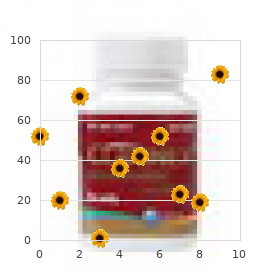
Imodium 2mg amex
If a single pathogenic sequence variant is recognized in a relevant gene the place recessive inheritance is expected, this substantially raises the likelihood that the other allele has a pathogenic variant. If standard diagnostic testing has been exhausted, recruitment to a research examine may be attainable if a high index of suspicion for an underlying molecular prognosis stays. These selections are guided by elements corresponding to the extent of scientific suspicion, the genetic heterogeneity of the phenotype, and the influence that a molecular prognosis might have on management. If the phenotype is fairly common and polygenic and/or nongenetic mechanisms are thought likely, further investigations for a monogenic trigger will not be appropriate. Clinical administration suggestions (including any screening, surgical, or chemoprophylaxis) may be given on the idea of existing scientific and familial information. This ought to embrace steering on when and whether households ought to come again for up-to-date information on testing developments. Management for a pathogenic variant Individualized risk estimation General threat estimates Once a (likely) pathogenic variant has been detected in the patient, the related illness risks have to be estimated. These could relate to components of illness not yet manifest within the affected proband in whom the variant was detected, or the risks of illness in relations also recognized as carrying the variant. Such risk estimates are typically derived from penetrance analyses in large case collection, accessible from the scientific literature or skilled physique guidance. However, these estimates are extremely topic to upward inflation due to ascertainment bias, since cases/families with more extreme phenotypes are more likely to have introduced clinically and been offered genetic testing. Risk estimation is particularly challenging for rare conditions where the scientific features of few affected patients have been described intimately. Risk estimation is usually based mostly on gene-level data, however information pertaining to particular variant sorts, gene regions, and even particular variants can also be variable (see Table 13. Furthermore, the chance estimates quoted for pathogenic variants in a specific gene might encompass a comparatively wide selection, even when supported by giant datasets. Distilling these dangers into an individualized threat for a particular patient is challenging as the clinician is empirically looking for to bear in mind the context of ascertainment, the family history, and the extra danger factors. For some conditions, instruments based mostly on modeling of large datasets can assist the clinician with this complex information integration. While such tools may be helpful, implementation may be limited by missingness of information and uncertain personal and household data.
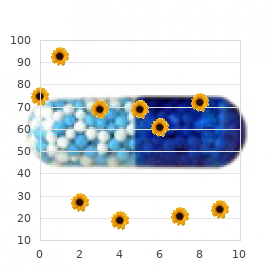
Imodium 2mg for sale
If the patient has a historical past of a latest surgery, the cause could be an infectious course of or residual issues. Presence of impaired Ask about impaired senses (sight or hearing), impaired gait, senses dizziness/vertigo, and slow tissue healing. Any impairment in these areas may trigger a delay or influence the restoration of the affected person. Deaths Include the relationship of the deceased particular person to the patient and the purpose for dying (specifically, disorders that affect the musculoskeletal system). Identify the relationship of the patient to the affected member of the family, the age of the affected member of the family, and at which age this family member developed the disease. Identify any risk components for osteoporosis; arthritis (rheumatoid, osteoarthritis, or gout); scoliosis/back problems; ankylosing spondylitis; or genetic issues (dwarfism, osteogenesis imperfecta). Inquire about any congenital abnormalities of the affected person (especially toes or hip). Ask the affected person to describe the nature of his or her work, in Hobbies or leisure activities Nutritional status, weight adjustments regard to physical and emotional effort and stress (overuse injury). Does the patient use any security precautions, corresponding to spinal help belt, splints, or an ergonomically right workstation Workrelated musculoskeletal problems may be associated with the following work postures and movements: repetitive movements and pace of work, drive of movements, vibrations, and temperature. Has the patient skilled any decrease in the capability to take part in traditional actions The patient can also be concerned in actions which are exacerbating the musculoskeletal drawback. An enhance in passive activities often decreases the amount of regular exercise and will increase the risk for harm when the affected person participates in sporadic train.
Discount 2 mg imodium with visa
With further manipulation the guidewire is superior into the inferior vena cava and the place is confirmed in a number of views. The hydrophobic catheter is advanced, and the wire is exchanged for a stiffer support wire. This assures the implanter that the leads are making good contact in the connector block and the appropriate lead has been positioned in the appropriate port. What is considered acceptable for continual thresh olds will rely upon the patient and associated comor bidities. Whether the coronary heart beat generator is being modified for battery depletion or on the idea of a recall or advisory, sufferers must be knowledgeable of the dangers of this rela tively minor process. This is especially necessary when the coronary heart beat generator is being changed on the premise of an advisory or recall, as a end result of the chance of system fail ure may be lower than the chance of pulse generator changeout; the sufferers want this data to make an informed decision. Although this complication rate is decrease than that reported in a multicenter survey of pulse generator problems that were seen in 8. Certain advisories for battery recall on pacemakerdependent sufferers are associated with erratic conduct like failure to output. The procedures 208 Cardiac Pacing, Defibrillation and Resynchronization 100 ninety eighty 70 Percent 60 50 40 30 20 10 zero N= 92% 4% 2% 1% 1% Battery 2. The percentages characterize proportion of pulse turbines that failed prematurely, defined by this registry as three years. Clinical expertise with pacemaker pulse turbines and transvenous leads: an 8year prospective multicenter research. This method not solely ensures consistency in postop erative care and management, but also permits for higher effectivity and provides an additional safety measure. If the affected person has an allergy listed in the electronic report, and medica tions ordered as a half of the order set. Although good sterile tech nique is crucial consider avoiding an implantrelated complication of an infection and a few controversy exists relating to postimplant antibiotic administration, we favor their use. After implantation, the incision is covered with sterile gauze and tape or a "coverlet.
Real Experiences: Customer Reviews on Imodium
Kalan, 28 years: The lower a half of the pinna (the lobule) consists of fats and subcutaneous tissue. Respiratory syncytial virus encephalitis and mumps, with a predilection for the cerebellum, manifest as intention tremor and ataxia. The palpated epidermal and/or dermal features of a lesion can be demonstrated with relative ease, assisting in formulation of a prognosis. A sleep diary ought to record the time of getting in and out of bed, sleep onset time, awakenings, naps, exercise, sleep treatment, and caffeine consumption.
Ugo, 34 years: If the vein is simply too small to settle for a lead, a guidewire is placed (lower left) and an introducer over it (lower right). The decision to undertake a diagnostic or therapeutic angiographic procedure requires sober assessment of the objectives of the investigation and its risks. For example, the Christmas tree arrangement of pityriasis rosea or the dermatomal association of herpes zoster is among the many necessary association patterns. Inquire about the variety of missed days of school (or work) due to ear problems.
Mojok, 40 years: However, the severity of the problem may be decreased using sure combos of predictors as a substitute of others [93], or by growing metapredictors tailor-made to this problem [92]. Collectively, the results counsel that all analyzed digital strategies have been ready in minor or major degree to detect and distinguish the instantaneous organic action of the drug on parasites. A rating of no less than 9 on these criteria is associated with good sensitivity and specificity for the prognosis of systemic sclerosis. Although surgical procedure alone could also be sufficient to precipitate delirium in a affected person with dementia, different triggers ought to nonetheless be investigated.
Rasul, 35 years: Associated signs Ask about associated signs including discoloration of the tooth, exudate from the encircling gums, halitosis, and edema. In the latter case, prognosis is linked extra to the severity of the underlying disease than to the coma itself, though coma in organ failure or sepsis is often a marker of grave illness that always carries with it a poor prognosis. The ventricular lead is deployed through the sheath, after which the sheath is eliminated. Integrative analysis identifies 4 molecular and scientific subsets in uveal melanoma.
Darmok, 64 years: Associated signs Ask about associated signs, including weight modifications, temperature intolerance, fatigue, vocal changes, and temper alterations. Chest Xray and device interrogation are performed the next day, along with fee sensor optimization. Treatment is dependent upon the underlying trigger; in some cases, myoclonus has resolved with antimicrobial treatment for opportunistic infections, retroviral therapy, or further symptomatic medicines. Nail texture should be the identical on all nails with no grooves, pits, traces, or spooning.
Sanuyem, 62 years: A painful, usually uneven axonal neuropathy typically appears 2 to three days after the onset of abdominal ache. The deviations of delta Ca mannequin can be accounted to the reality that Ca dose predicted by this model is in an addition to the Calcium requirement for regular bone development. Digital imaging information know-how for biospeckle activity evaluation relative to micro organism and parasites. Assessing mutation-induced binding affinity change by protein interface profiles with pseudo-counts.
10 of 10 - Review by C. Zakosh
Votes: 336 votes
Total customer reviews: 336
References
- Rasmussen JE. Erythema multiforme, Stevens-Johnson syndrome and toxic epidermal necrolysis. Dermatol Nurs. 1995;7:37-43.
- Linehan WM, Spellman PT, Ricketts CJ, et al.; for The Cancer Genome Atlas Research Network. Comprehensive molecular characterization of papillary renal-cell carcinoma. N Engl J Med 2016;374(2):135-145.
- Alpert JS, Thygesen K, Antman EM, Bassand JP: Myocardial infarction redefinedoa consensus document of the Joint European Society of Cardiology/American College of Cardiology Committee for the redefinition of myocardial infarction. Eur Heart J 2000; 21:1502-1513.
- Theoharides, T.C., Whitmore, K., Stanford, E., Moldwin, R., O'Leary, M.P. Interstitial cystitis: bladder pain and beyond. Expert Opin. Pharmacother 2008;9:2979-2979.
- Munzel T, et al. Explaining the phenomenon of nitrate tolerance. Circ Res 2005;97:618-628.
- Crump M, Leppa S, Fayad L, et al. Randomized, double-blind, phase III trial of enzastaurin versus placebo in patients achieving remission after first-line therapy for high-risk diffuse large B-cell lymphoma. J Clin Oncol 2016;34(21):2484-2492.
- Ralph G, Tamussino K, Lichtenegger W. Urological complications after radical hysterectomy with or without radiotherapy for cervical cancer. Arch Gynecol Obstet 1990;248(2):61-65.

